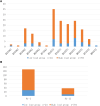Correlation of DNA load, genotyping, and clinical phenotype of Mycoplasma pneumoniae infection in children
- PMID: 38655275
- PMCID: PMC11035820
- DOI: 10.3389/fped.2024.1369431
Correlation of DNA load, genotyping, and clinical phenotype of Mycoplasma pneumoniae infection in children
Abstract
Introduction: This study aimed to investigate the correlation between Mycoplasma pneumoniae (MP)-DNA load in the bronchoalveolar lavage fluid (BALF) of children with MP pneumonia (MPP) and its subtypes, relevant laboratory data, imaging, extrapulmonary complications in infected children, and its clinical significance in evaluating the disease.
Methods: Children hospitalized with MPP at Tianjin Children's Hospital between December 2017 and December 2020 were selected for the study, excluding those with mixed viral, bacterial, and fungal infections. Children were divided into low- and high-load groups according to the MP DNA load in BALF using real-time quantitative fluorescence polymerase chain reaction (PCR). After a successful MP culture, positive specimens were subjected to PCR-Restriction fragment length polymorphism and Multiple-locus variable number tandem repeat analysis typing. Basic data, clinical information, laboratory data, and radiological results were collected from all children included in the study.
Results: The PI-I type dominated the different load groups. Children in the low-load group had more wheezing and shortness of breath; however, children in the high-load group had a higher length of hospitalization, maximum fever temperature, higher chills/chilliness, incidence of abdominal pain, and higher C-reactive protein (CRP), procalcitonin (PCT) and aspartate aminotransferase (AST) levels. Children in the high-load group were more likely to have imaging changes such as pleural effusion, and the incidence of respiratory infections and extrapulmonary complications was higher than that of those in the low-load group. We applied Spearman's correlation analysis to clarify the relationship between MP DNA load and the clinical severity of MPP. We found that MP DNA load was positively correlated with length of hospitalization, maximum fever temperature, CRP, PCT, Interleukin-6 (IL-6), and AST levels, and negatively correlated with fever and cough durations, white blood cell count (WBC), and proportion of monocytes (MONO). The degree of correlation was as follows: length of hospitalization > IL-6 > cough duration > AST > fever duration > PCT > WBC > proportion of MONO > maximum fever temperature > CRP levels.
Conclusions: MP DNA load was not correlated with MP typing but was significantly correlated with the children's clinical phenotype. Therefore, the MP DNA load helps in the early diagnosis of infection and can better predict disease regression.
Keywords: DNA load; children; clinical characteristics; genotyping; mycoplasma pneumoniae.
© 2024 Wang, Wang, Yin, Zeng, Yao, Liu, Fang, Ma and Cui.
Conflict of interest statement
The authors declare that the research was conducted in the absence of any commercial or financial relationships that could be construed as a potential conflict of interest.
Figures
Similar articles
-
Analysis of cytokine levels, cytological findings, and MP-DNA level in bronchoalveolar lavage fluid of children with Mycoplasma pneumoniae pneumonia.Immun Inflamm Dis. 2023 May;11(5):e849. doi: 10.1002/iid3.849. Immun Inflamm Dis. 2023. PMID: 37249293 Free PMC article.
-
[Relationship between bronchoalveolar lavage mycoplasma load and clinical characteristics in children with Mycoplasma pneumoniae pneumonia].Zhonghua Er Ke Za Zhi. 2013 Oct;51(10):736-40. Zhonghua Er Ke Za Zhi. 2013. PMID: 24406224 Chinese.
-
Clinical profiles of Mycoplasma pneumoniae pneumonia in children with different pleural effusion patterns: a retrospective study.BMC Infect Dis. 2024 Sep 4;24(1):919. doi: 10.1186/s12879-024-09829-5. BMC Infect Dis. 2024. PMID: 39232651 Free PMC article.
-
Analysis of clinical characteristics and laboratory examination data of 112 cases of Mycoplasma pneumoniae pneumonia in children.Medicine (Baltimore). 2024 Nov 22;103(47):e40628. doi: 10.1097/MD.0000000000040628. Medicine (Baltimore). 2024. PMID: 39809213 Free PMC article.
-
Mycoplasma Pneumoniae Infection and Persistent Wheezing in Young Children: A Retrospective Case-Control Study.Front Pediatr. 2022 Mar 7;10:811086. doi: 10.3389/fped.2022.811086. eCollection 2022. Front Pediatr. 2022. PMID: 35321015 Free PMC article.
Cited by
-
The Clinical Significance of Pathogen Loads and Macrolide Resistance Levels for Macrolide-Resistant Mycoplasma pneumoniae Pneumonia in Children.J Inflamm Res. 2024 Oct 15;17:7339-7346. doi: 10.2147/JIR.S491981. eCollection 2024. J Inflamm Res. 2024. PMID: 39429852 Free PMC article.
References
LinkOut - more resources
Full Text Sources
Research Materials
Miscellaneous


